United States Marine Corps Forces Special Operations Command
| Marine Corps Forces Special Operations Command | |
|---|---|
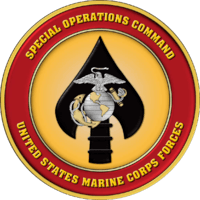 Seal of the Marine Corps Forces Special Operations Command | |
| Active | 24 February 2006 – present[1] |
| Country |
|
| Branch |
|
| Type | Special Operations |
| Role | |
| Size |
3,195 positions authorized:[2]
|
| Part of |
|
| Garrison/HQ | Camp Lejeune, North Carolina |
| Motto(s) | "Always Faithful, Always Forward" |
| March | MARSOC Always Faithful, Always Forward |
| Anniversaries | 7 September 2015 |
| Engagements | |
| Commanders | |
| Current commander | Major General Daniel D. Yoo[4] |
| Notable commanders |
Joseph L. Osterman Mastin M. Robeson Dennis J. Hejlik Paul E. Lefebvre Mark A. Clark |
United States Marine Corps Forces Special Operations Command (MARSOC) is a component command of the United States Special Operations Command that comprises the Marine Corps' contribution to SOCOM. Its core capabilities are direct action, special reconnaissance and foreign internal defense. MARSOC has also been directed to conduct counter-terrorism, and information operations.[5]
History and lineage
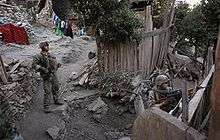
Its creation was announced on 23 November 2005 by US Defense Secretary Donald Rumsfeld, following a meeting between him, the USSOCOM commander General Bryan D. Brown, and the Marine Corps Commandant General Michael Hagee on 28 October 2005. MARSOC was officially activated on 24 February 2006 with ceremonies at Camp Lejeune, North Carolina.
The potential participation of the Marine Corps in SOCOM has been controversial since SOCOM was formed in 1986.[6] At the time, Marine Corps leaders felt that their Force Reconnaissance units were best kept in the Marine Corps' MAGTF command structure, and that the detachment of an elite Marine Special Operations unit from the Marine Corps would be to the detriment of the Marine Corps as a whole. A re-evaluation following the September 11 attacks and the War on Terrorism, along with new policy established by Secretary Rumsfeld and then-Commandant Gen. James L. Jones at The Pentagon, caused the Marine Corps to work towards integration with SOCOM. The establishment of MARSOC represented the most significant step towards that goal, and followed the establishment of MCSOCOM Detachment One (DET1), a small Marine Corps detachment formed as a pilot program to test Marine Corps integration into SOCOM. It was made up of mostly Force Recon Marines from 1st and 2nd Force Reconnaissance Companies along with other hand-picked support men and served with Navy SEALs under Naval Special Warfare Group One. Detachment 1 conducted a multitude of special operations in Iraq alongside their Special Operations brothers of the sister services. SOCOM conducted a study of the unit's deployment, which clearly indicated success and strong performance. Detachment 1 was disbanded in 2006 soon after the creation of MARSOC.
The first Marine Special Operations Company was stood up in June 2006.[7] MARSOC's initial deployment to Afghanistan in 2007 was mired with controversy when the units Fox company was sent back to the United States and its commander relieved from duty after a shooting incident. The incident that resulted in as many as 19 civilians killed involved a complex ambush by insurgents that included a suicide VBIED and small arms fire, it was alleged that the MARSOC operators killed the civilians whilst attempting to suppress the enemy firing points.[8] MARSOC Marines also took part in Operation Enduring Freedom – Philippines.[9]
Following General Petraeus' take over of command in Afghanistan in 2010, in support of the ALP/VSO programme (Afghan Local Police/Village Stability Operations), SOF in Afghanistan were task-organised into battalion level SOTF (Special Operations Task Forces), each with a geographic area of responsibility - for MARSOC, this was western Afghanistan and Helmand Province. In March 2012, MARSOC teams suffered several casualties to Green on Blue attacks. In July 2012, a patrol of Afghan Army Commandos was ambushed by insurgents from a number of buildings in Badghis Province, three Afghans were wounded by small arms fire, Gunnery Sergeants Jonathan Gifford and Daniel Price raced forward on an ATV to retrieve the wounded under direct fire from the enemy. After evacuating the wounded to an emergency HLZ (Helicopter Landing Zone) from where they were safely medevaced, they returned to firefight and assaulted the enemy positions in a fierce close-quarter battle. Whilst throwing grenades down the chimney of an insurgent-occupied building, they were struck and killed by PKM fire, for his actions that day Price was awarded the Silver Star.[10]
It was deployed supporting the Global War on Terrorism in December 2013 alongside the 26th Marine Expeditionary Unit (Special Operations Capable) where they conducted various special operations missions, ranging from Direct action (military), reconnaissance and other mission sets.[7]
Since MARSOC's first deployment, it has become a strong partner in SOCOM and proven itself able to conduct full-spectrum special operations. They have successfully conducted both long-term counterinsurgency under the VSO program and carried out complex Direct Action tasks.[8]
The first Marine Special Operations Individual Training Course began at Camp Lejeune on 6 October 2008.[11] MARSOC's stated end-goal is 850 CSOs.[12]
Organization
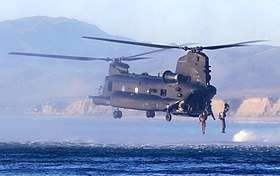


MARSOC's organization was finalized in 2007. The base unit of MARSOC is the fourteen-man Marine Special Operations Team (MSOT), commanded by a captain (O-3) as Team Commander, assisted by a master sergeant (E-8) as Team Chief. Each team has two identical squads, or Tactical Elements, each led by a gunnery sergeant (E-7) as Element Leader. MARSOC is based at Camp Lejeune, North Carolina and is split into three subordinate commands:
| Name | Insignia | Headquarters | Description |
|---|---|---|---|
| Marine Raider Regiment[13] | Camp Lejeune, NC and Camp Pendleton, CA | MRR consists of a Headquarters Company and three Marine Raider Battalions (1st, 2nd and 3rd). The MRBs are tasked with direct action, special reconnaissance, counter-terrorism, and information operations. They are also trained to carry out peacetime foreign internal defense[14] and unconventional warfare. This includes giving military training to friendly foreign nations. Each MRB consists of four Marine Special Operations Companies (MSOCs) that contain four Marine Special Operations Teams (MSOTs) in each Company. The organization allows a Team to operate on its own if needed, but maintains the ability to operate as part of a larger unit such as an MSOC or SOTF, similar to Army Special Forces ODA/B.[15] The core personnel strength of the MRBs was initially drafted from Force Reconnaissance Marines. | |
| Marine Raider Support Group[13] | Camp Lejeune, NC | The MRSG, comprising the Group HQs, 1st, 2nd and 3rd Marine Raider Support Battalions, contain the Command's administrative, and support assets.[16] The MRSG trains, equips, structures, and provides specially qualified Marine forces to augment MSOTs, including operational logistics, intelligence, multipurpose canines handlers, Firepower Control Teams and communications support in order to sustain worldwide special operations missions.[17] | |
| Marine Special Operations School | Camp Lejeune, NC | Conducts screening, training, selection, assessment, and development functions for MARSOC.[18] |
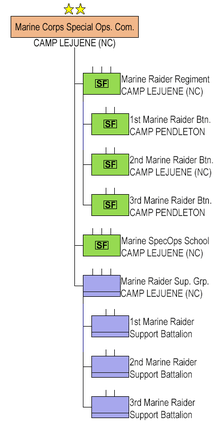
Special Operations Combat Service Specialist
Special Operations Combat Service Specialists (SOCS-Ss) are Combat Service Support Marines who serve one standard tour with MARSOC in their primary MOS, such as Motor Transport or Logistics. Their training includes core skills for joint and interagency work as well as enhanced SOF combat skills training to enable their successful integration and survivability in special operations environments.[19]
Special Operations Capabilities Specialist
Special Operations Capabilities Specialists (SOCS) are Combat Support Marines that are able to join MARSOC based upon their MOS skill. They receive advanced special operations forces training and certification. SOCSs are operational and tactical force multipliers and frequently deploy alongside Critical Skills Operators (CSOs). SOCS billet fields include Intelligence, Communications, Explosive Ordnance Disposal, Dog Handlers, and Fire-Control Specialists. Special Operations Capabilities Specialist are awarded the AMOS of 8071, and return to the operating forces after an extended tour of service with MARSOC.[19]
Prerequisites
All Marines are screened to ensure that the Marines joining MARSOC meet the established prerequisites for duty within the command.
Screening
Selection of the right personnel begins with a rigorous screening process designed to identify the right Marines for the right billet within MARSOC. Operational billets were opened to females as of 2016.[21] Screening takes place in 3 stages: record screening, physical screening, and a psychological and medical evaluation.
Special Operations Training Course
The Special Operations Training Course (STC) is six weeks of unhindered, realistic, challenging basic and intermediate Special Operations Forces (SOF) war fighting skills training. During STC the Special Operations Capabilities Specialists will also attend Survival, Evasion, Resistance and Escape (SERE) training along with a MARSOF Level 1 Course specific to their MOS: Explosive Ordnance Disposal (6 weeks), Communications (12 weeks), Intelligence (4–6 weeks), Joint Terminal Attack Controller (4 weeks), Multi-Purpose Canine (10 weeks).[19]
Critical Skills Operators
Critical Skills Operators are the primary special operations Marines within MARSOC. They are trained to execute a variety of missions. Specialized training also provides capabilities in language fluency necessary for crossing cultural barriers, allowing CSOs to connect with the local forces as well as civilians.[22] Marines designated CSOs are awarded MOS 0372. Critical Skills Operators (CSOs) are assigned to Marine Special Operations Teams (MSOT), Companies (MSOC) and Battalions (MSOBs).[23]
Raider legacy
On 6 August 2014, MARSOC claimed and officially bestowed the prestigious Marine Raider moniker upon their subordinate combat units (Marine Special Operations Regiment) in commemoration of the fabled and elite amphibious light infantry unit that operated during World War II.[24]
Marine Raider Insignia
In August 2016, the Marine Corps approved a new Marine Special Operator Insignia for wear by graduates of the five-phase Individual Training Course. Upon its approval, Maj. Gen. Carl Mundy III, MARSOC commander, said in a statement:
"The individual MARSOC operator must be trained and educated to think critically and function in an increasingly complex operating environment – to understand and interact in dynamic, dangerous and politically-sensitive battlefields. Our rigorous training pipeline ensures that a newly minted critical skills operator has developed the skills required for full spectrum special operations. This badge serves as a visual certification that they have trained and prepared to accept their new responsibilities."[25]
The pin device will first be issued to the next ITC graduating class of critical skills operators. Critical skills operators and special operations officers already in the field will receive their pins later.
In popular culture
- The character Bob Lee Swagger, originally created for a series of novels by author Stephen Hunter, followed by a feature film and tv series, both titled "Shooter", is a Force Recon Scout sniper, based on noted Vietnam veteran Carlos Hathcock.
- In the film The Marine 3: Homefront, Mike "The Miz" Mizanin portrays former Force Recon Marine and MARSOC Critical Skills Operator, Jake Carter.
- In Battlefield 4, Tombstone squad consists of MARSOC CSOs and the main protagonist.
See also
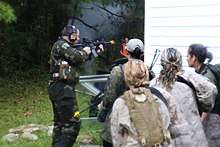
- 2007 Shinwar shooting
- Air Force Special Operations Command
- Force Reconnaissance
- Marine Raiders
- MCSOCOM Detachment One
- Organization of the United States Marine Corps
- Special Operations
- United States Army Special Operations Command
- United States Naval Special Warfare Command
- United States Special Operations Command
References
- ↑ SOCOM Public Affairs (2014). SOCOM Fact Book 2014 (PDF). SOCOM Public Affairs. Archived from the original (PDF) on 4 December 2013.
- ↑ "SPECIAL OPERATIONS FORCES : Opportunities Exist to Improve Transparency of Funding and Assess Potential to Lessen Some Deployments" (PDF). Gao.gov. Retrieved 2017-06-30.
- ↑ "More U.S. troops are being wounded in Iraq and Syria, the Pentagon quietly acknowledges". Military Times. 5 January 2017.
- ↑ "MARSOC Leaders". Marsoc.marines.mil. 2016-08-04. Retrieved 2017-06-30.
- ↑ Hejlik, Major General Dennis J; Gilmore, Major Cliff W; Ingram, Sergeant Major Matthew P (August 2006). "Special Operations Marines and the Road Ahead". Marine Corps Gazette. Marine Corps Association. ISSN 0025-3170.
- ↑ "Archived copy". Archived from the original on 20 December 2016. Retrieved 19 December 2016.
- 1 2 MARSOC, Part 1: Devil Dogs of SOCOM. Sadefensejournal.com (2012-02-10). Retrieved on 2014-05-24.
- 1 2 Neville, Leigh, Special Forces in the War on Terror (General Military), Osprey Publishing, 2015 ISBN 1472807901 ISBN 978-1472807908, p.165
- ↑ Neville, Leigh, Special Forces in the War on Terror (General Military), Osprey Publishing, 2015 ISBN 978-1-4728-0790-8, p.183
- ↑ Neville, Leigh, Special Forces in the War on Terror (General Military), Osprey Publishing, 2015 ISBN 1472807901 ISBN 978-1472807908, p.161-162, p.166-167
- ↑ Armistead, Michael Warren (20 October 2008). "First US MARSOF Individual Training Course has begun" (Press release). United States Marine Corps. Retrieved 15 November 2008.
- ↑ Kyle McNally. "ITC 2-11 Graduation". Marines.mil.
- 1 2 Hodge, Hope (2015-06-11). "marsoc-units-raiders-name-10-month-delay". Marinecorpstimes.com. Retrieved 2017-06-30.
- ↑ Stahlman, Josephh (28 August 2007). "MSOAG Marines get LIT". United States Marine Corps. Archived from the original on 15 June 2008. Retrieved 20 November 2008.
- ↑ "Questions & Responses Page". U.S Marine Corps Forces Special Operations Command. United States Marine Corps. 30 October 2007. Retrieved 28 May 2008.
- ↑ "Marine Special Operations Support Group". U.S. Marine Corps Forces Special Operations Command. United States Marine Corps. 15 November 2008.
- ↑ "Marine Raider Support Group". Marsoc.marines.mil. 2016-08-04. Retrieved 2017-06-30.
- ↑ Maurer, Kevin (26 October 2008). "Marine Leader: Unit A Good Fit". Fayetteville Observer. Associated Press.
- 1 2 3 Join Us - MARSOC Recruiting. Marsoc.com. Retrieved on 2014-05-24.
- 1 2 3 4 5 "Prerequisites". MARSOC Recruiting.
- ↑ Schehl, Matthew L. "marines-special-operations-command-gets-first-female-applicants". Militarytimes.com. Retrieved 2017-06-30.
- ↑ "MARSOC Command Pamphlet" (PDF). MARSOC. March 2013. Archived from the original (PDF) on 24 December 2013. Retrieved 23 March 2018.
- ↑ Critical Skills Operator Training & Selection. Americanspecialops.com. Retrieved on 2014-05-24.
- ↑ Lamothe, Dan (6 Aug 2014). "Marine Corps to adopt iconic Raiders name for its Special Operations troops". Washington Post. WashingtonPost.com. Retrieved 29 August 2014.
- ↑ Eckstein, Megan. "Marine Corps Announces New MARSOC Insignia Pin". U.S.N.I. News. U.S. Naval Institute. Retrieved 23 August 2016.
![]()
External links
![]()

